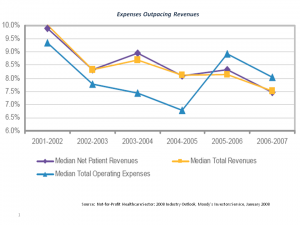· Total staff expenses have been reviewed; cuts made for those roles viewed as less than mission critical. The impact of those cuts has not been completely experienced to date although there is an overall sense within the business unit by employees that they are working harder to earn less.
· Direct and indirect cost controls are in place with the big ticket costs limited or cut and some degree of the bone expenses limited as well. Leadership believes that most opportunities for cost savings have been tapped.
· Financial leadership continues to read that the recession is either over or well on the way to repair. Sales and the general gut mood still say the opposite.
The post mortem of redeveloping financial targets and budgets is still out as the 2010 budgets are being cemented. Through all of this there is still uneasiness among leadership and workers that the full impact of 2008 and 2009 decisions is yet to be experienced.
Healthcare costs remain at the forefront of the budget expenses and even with the vote last Saturday to move the Senate version of healthcare reform to a full floor debate, the tangible impact of reform may or may not be fully evident in 2010. Human resource professionals are determining the impact of public option currently written into both the Affordable Health Care for America Act (House) and the Patient Protection and Affordable Care Act (Senate).
A recent Kaiser Family Foundation poll surveying consumer priority for healthcare legislation found:
· Deficit neutrality ranked in the top three priorities for Republicans and independents.
· Providing sufficient government financial help to maximize the number of uninsured able to access health insurance ranked in the top three for Democrats.
· Public option ranked near the bottom for consumers of both parties and independents.
· When asked if they favor or oppose having a public plan to compete with private insurers, 59% — a substantial a majority, support the concept. Access, cost of care, and the need to fix the healthcare system were cited by supporters as key attributes; descanters cited increased costs and government intervention in healthcare most often.
The survey asked if consumers “Would (you) favor or oppose requiring employers to offer health insurance to their workers or pay money into a government fund that will pay to cover those without insurance?” 68% of the respondents indicated they favored employer requirements. Understandably, for those who supported the plan and asked if they would still offer their support if the additional cost resulted in some staff layoff, only 30% were in favor of requirements.
With this backdrop, business unit leadership still needs to develop their budget assumptions for the coming year. Basic assumptions based on a historical review of the past two years include:
1. A slow recession recovery is inevitable. This means fearful consumers spending less, fearful employers looking for additional indirect and direct cost cutting, somewhat improved investment income.
2. Completion of the larger capital projects put on hold during 2008 – 2009.
3. Healthcare costs quoted for 2010 in place throughout the year and increases for 2011.
4. Increased attention to innovation and core market needs in an effort to build new lines of revenue to offset losses.
Recommendations for 2010? Continued expense management is crucial and attention to the morale of the employee are priorities. Expense management is a basic, Budget 101 element crucial to successfully reaching any goal and its objective. Accountabiltiy and responsibility for all expndeitures lies with all staff – senior leader, manager, line worker. The moral of the team is different. Belief that having employment with benefits is sufficient is not enough. With increased demands on output and little to no increase in payment, output levels require support and encouragement. This is the time for leadership to step to the forefront and offer transparency, understanding, and support internally.
Leadership will also have a choice in 2010 regarding it healthcare plan and subsequent coverage. The unemployed and those with little to no access to healthcare coverae will continue as blight on the national canvas; concurrently it will serve as ground zero for ongoing debate and horse trading within the reform legislation. As the day concludes and 2010 budget move forward, the stark reality that a large portion of children in this nation lack healthcare coverage or access and a large portion of seniors will continue to find it difficult to find a physician accepting Medicare and/or living within the doughnut hole of pharmaceutical coverage, will be present.
Final corporate budgets are nearing completion with boards and senior leadership coolly awaiting word on their 2010 profit margins. At this stage, there are some basics business units have undertaken if their objective is to remain solid though the past two years:

Leave a Reply